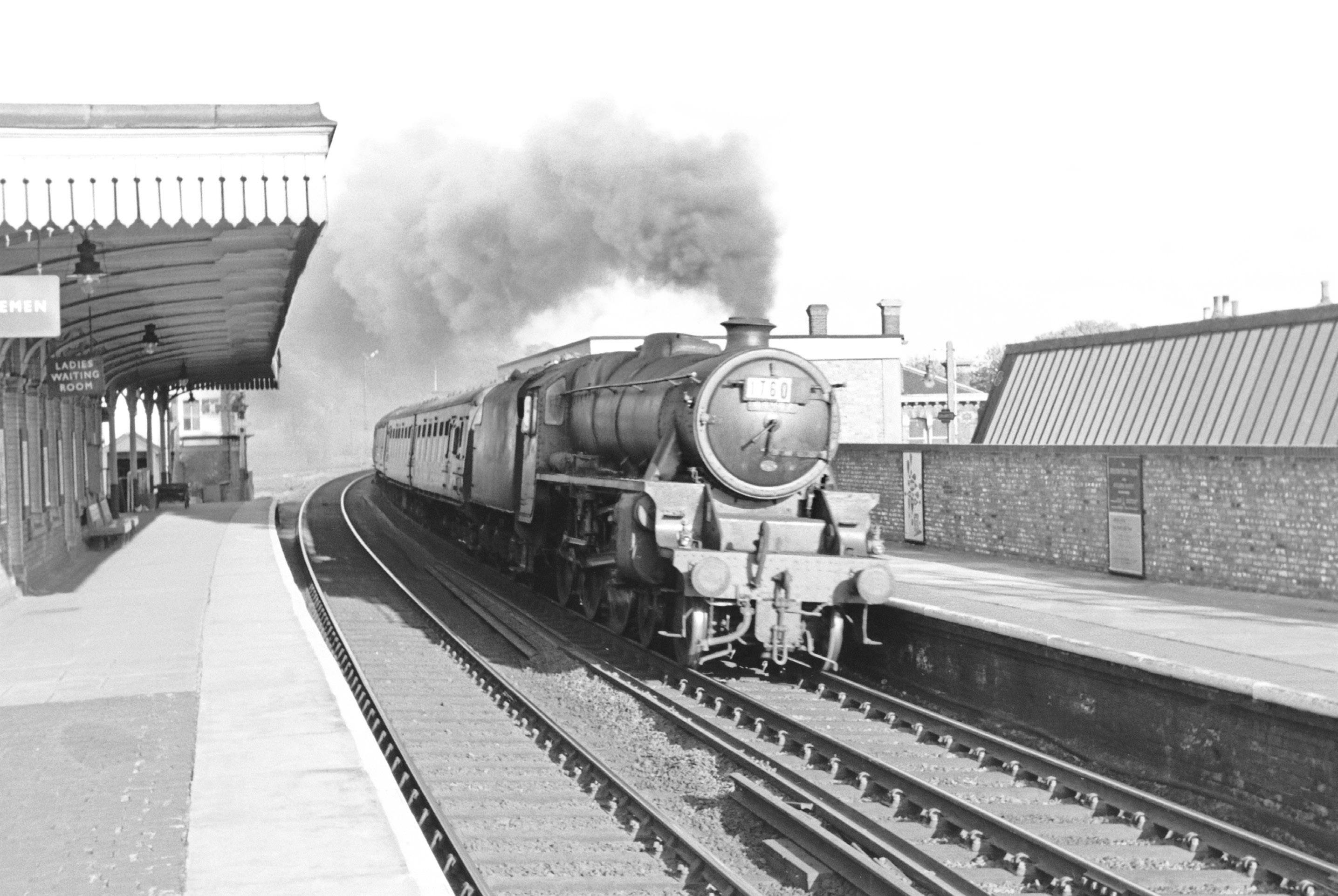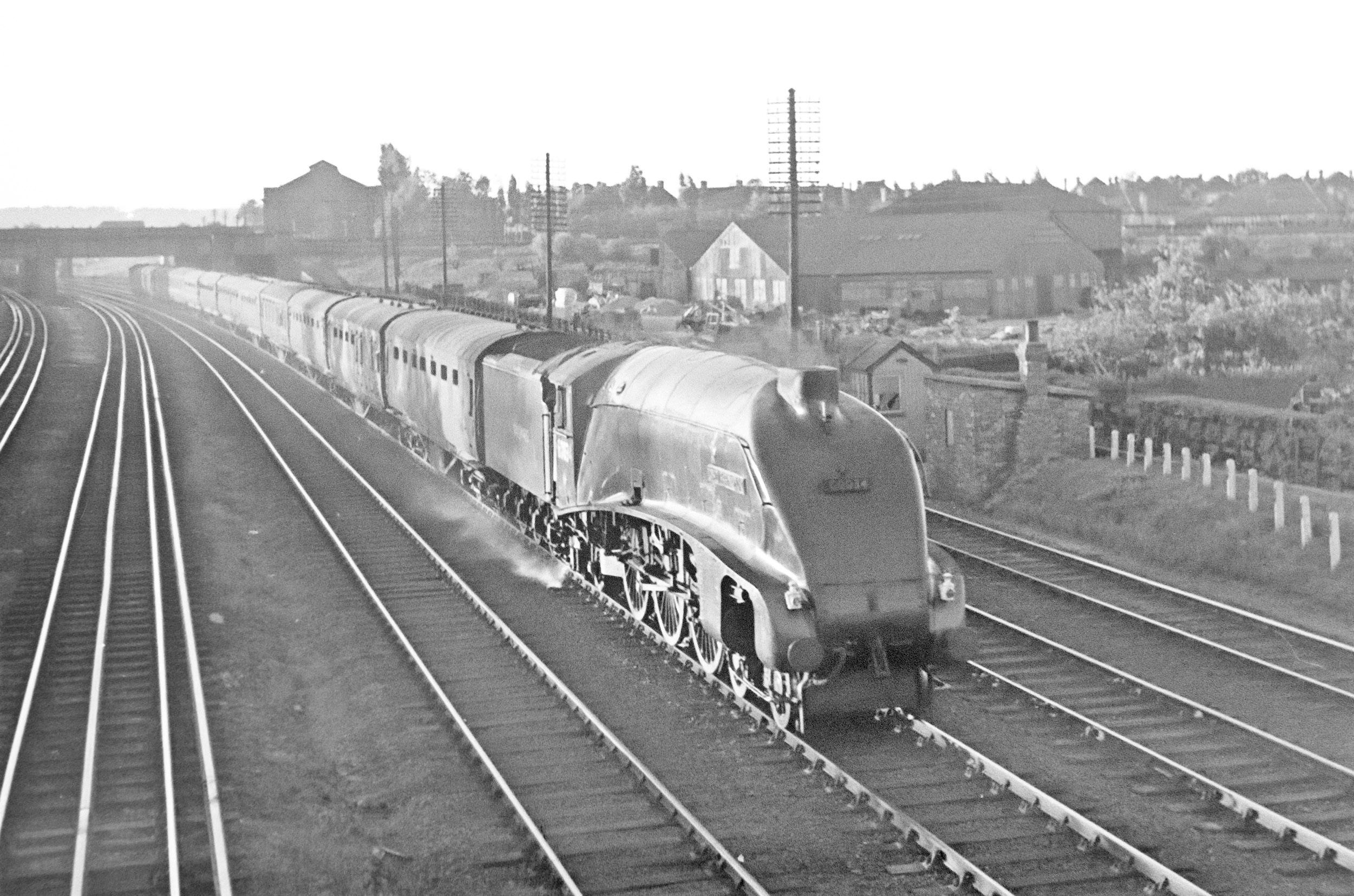

Rails Around Watford
Compiled by Robert Freeman

Black Five 4-6-0 44947, a long-term resident of Blackpool shed, storms through Berkhamsted on the down fast with what is probably a football special. At the end of the platform is the signal box which was situated between the fast and slow tracks and through the smoke the very tall down home signals can be glimpsed. The building on the right belonged to Shaw and Kilburn, a local garage and service station. On the left is a ladies’ waiting room: today it is still there but is a general one. Berkhamsted is only one of two stations (the other being Harrow and Wealdstone) on the southern part of the WCML to retain its original 19th century buildings. (Derek Potton)

The Nickey Line was unusual in that it continued beyond Hemel Hempstead and ended at a halt. This was Heath Park Halt and the special train has now moved on, past the site of it and onto the goods only section which served a gasworks, just short of the WCML. Great interest is being shown by passers-by as the train crosses the old A41 (now the A4251). A short stub of the embankment the train is on still exists, the only remnant of the line left south of Hemel Hempstead (MR), the rest, including a three-arch viaduct, having disappeared under the New Town. (Nick Nicolson)

Two 3-car Oerlikon EMUs (named after their electrical equipment) stand in Platform 1 ready to form a service to Euston on 22 April 1957. More than 70 of these units were introduced by the London and North Western Railway in two batches in 1915 and 1921 to work the intensive services on the electrified DC New Line from Euston to Watford, from Watford to Broad St and on the North London Line from Broad St to Richmond. They also worked on the branches to Rickmansworth Church St and Croxley Green. The accommodation in them was positively luxurious compared to the “ironing board” seating of many modernday units! They were replaced by what later became Class 501 in 1957-60. On the right some buildings at the front of the station have been demolished and this space is where the bus station is situated today. (A E Bennett)

Transition on the DC line on 6 July 1958: Two of the new units (later Class 501) in Platforms 2 and 4 are sandwiching one of their predecessors in Platform 3. There was a distinct Southern Region look to these units; hardly surprising as they were built at Eastleigh, from 1957 onwards. The Oerlikons had gone by 1960, but some of the 25 LMS compartment sets, built in 1926-32 to augment the fleet, lasted a little longer into 1963. The ‘B9’ headcode shows that a train has come from Croxley Green. (A E Bennett)

This photo is “smudged” by heavy falling snow but is well worth including as it is wonderfully atmospheric and also shows the original Carpenders Park station with an Oerlikon set calling at it. An unidentified Princess Royal Pacific (possibly 46208) is sweeping past with the up ‘Merseyside Express’. The original station had wooden platforms and was situated 230 yards further north than the current one. It was first built to serve a local golf course and started out as a request stop. It had a kink in the track alignment on the approach from the south, which was eliminated when the station closed on 17 November 1952, being replaced by the current station with its concrete buildings. (Roy Vincent)

9F 2-10-0 92154 of Wellingborough shed is hauling the 6.10am Wellingborough to Willesden ballast train passing the signal box on the up slow on 2 February 1963, in the middle of the very harsh “Big Freeze” winter that year. Freight locomotives from Midlands sheds were very common visitors to the London end of the West Coast Main Line, usually heading an endless procession of coal and mineral trains to serve the Capital. Like this train, they were routed over the now long-closed line from Market Harborough to Northampton. Note the gas lamp and the goods shed in the yard behind. (David Idle)

One of the small number of two-car Park Royal DMUs (only 20 sets were built) has just arrived at Belmont from Harrow and Wealdstone. No date is given but one of the newspaper placards proclaims a Royal Visit to Canada and this took place in 1959. In order to combat the dwindling traffic mentioned in the previous caption, Belmont was opened by the LMS on 12 September 1932 as the only intermediate station on the branch to Stanmore which can be seen continuing into the distance here, but which was freight only by this date, closing to goods 6 July 1964. The remaining part of the line to Belmont closed just three months later as a victim of the Beeching cuts on 5 October 1964. (Transport Treasury)

What an exciting time it must have been for the railway enthusiasts of the day during the Locomotive Exchange Trials of 1948, to see the former rivals of the Big Four being tried out on each other’s lines during the first year of British Railways! Here, just south of Kenton again, we see A4 Pacific 60034 Lord Faringdon working the 12.55pm from Carlisle nearing the end of its journey to Euston. The photograph was taken at 8.10pm on 18 May 1948 and the train is beautifully catching the last rays of the setting sun. 60034 was to be one of the last A4s in service, being withdrawn from Aberdeen Ferryhill in August 1966. (J C Flemons)

Continuing from “Rails Around Aylesbury Vale,” this companion volume explores the West Coast Main Line from Tring Summit to Wembley Central and five branch lines. Spanning from the 1940s to the mid-1960s, the book captures steam-hauled expresses, early diesels, and the first AC electrics.
Authored by a lifelong railway enthusiast, “Rails Around Watford” features a personal collection of photographs from the Transport Treasury archive. This nostalgic journey into a bygone era is a must-have for railway historians and enthusiasts alike, highlighting the charm and character of British railways’ golden age.



